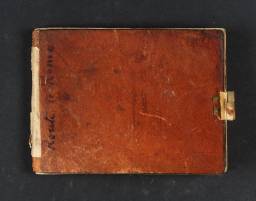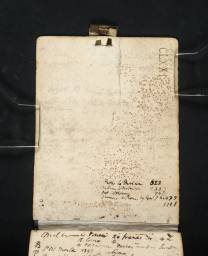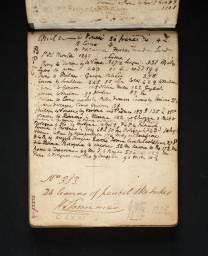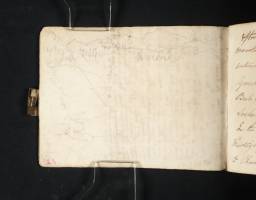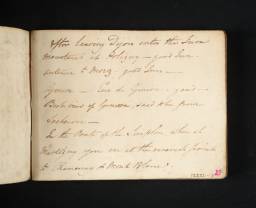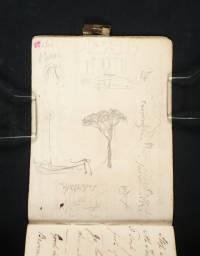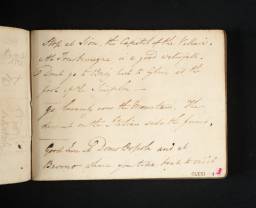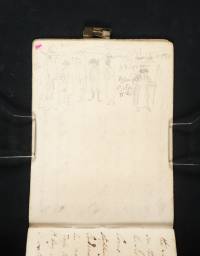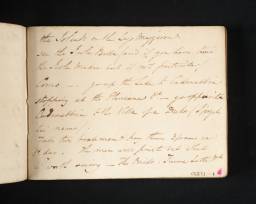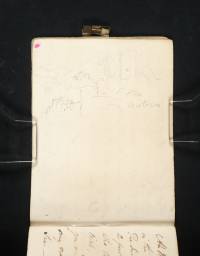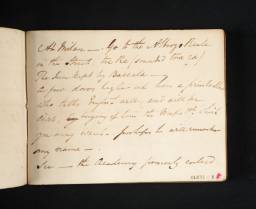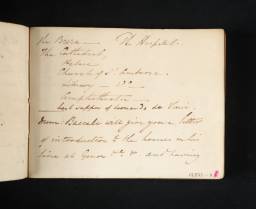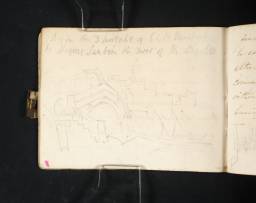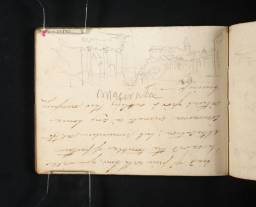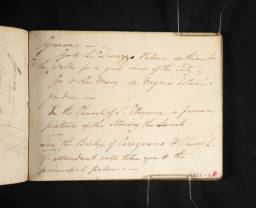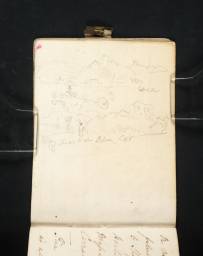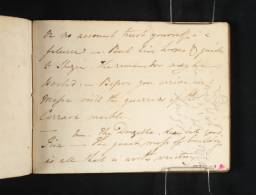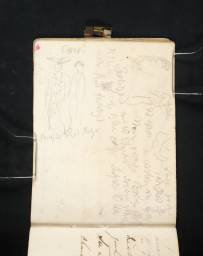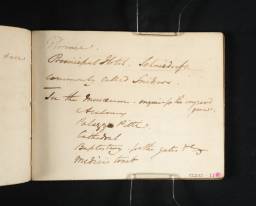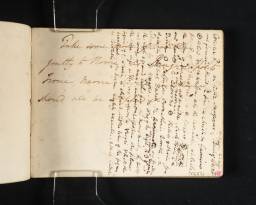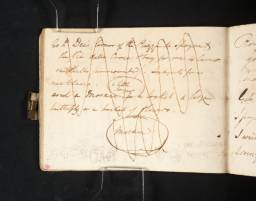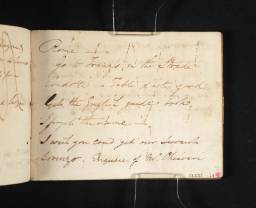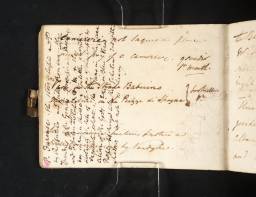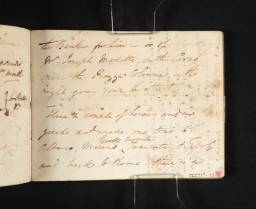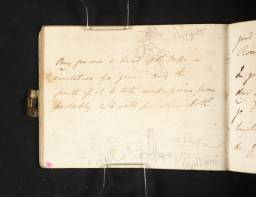Turner Bequest CLXXI
Sketchbook bound with brown leather and a paper label on the spine printed ‘Now is’, and a brass clasp
38 leaves of white wove writing paper, approximate page size 88 x 114 mm
Made by William Allee, Hurstbourne Prior Mill, Hampshire; various pages watermarked ‘ALLEE | 1813’
38 leaves of white wove writing paper, approximate page size 88 x 114 mm
Made by William Allee, Hurstbourne Prior Mill, Hampshire; various pages watermarked ‘ALLEE | 1813’
Inscribed by the artist in black ink ‘Route to Rome’ on the front cover (D40673)
Accepted by the nation as part of the Turner Bequest 1856
Exhibition history
References
One of twenty-three sketchbooks related to Turner’s first Italian tour from August 1819 to January 1820. The title, Route to Rome, follows the artist’s own label and reflects the content of the book which is largely comprised of notes in preparation for the trip written by James Hakewill. Additionally, interspersed throughout are a number of on-the-spot pencil sketches and inscriptions by Turner, principally dating from the outward leg of the journey towards Rome.
James Hakewill (1778–1843), was an architect and artist who, in the summer of 1818, commissioned Turner to collaborate with him on a topographical publication, the Picturesque Tour of Italy. Turner, who at the time had yet to visit Italy for himself, produced twenty finished watercolour views of famous sites, all of which were based upon Hakewill’s own pencil drawings made during a tour of the country with his wife in 1816–17 (British School at Rome Library).1 Eighteen of these were subsequently engraved and appeared together in the final book, published by John Murray in 1820.2 It seems certain that involvement in this project and the close working relationship with Hakewill played a key role in Turner’s decision to finally set out on his first Italian tour in the summer of 1819. In anticipation of his departure, Hakewill filled this small pocket-sized notebook with written advice designed to aid his travels. His extensive notes include a complete suggested itinerary, see folios 38 verso–35 (D13933–D13924, forward from the back of the book), as well as helpful information on accommodation and sightseeing, see folios 2–25 (D13861–D13905). The suggestion that Hakewill was the author of these inscriptions was first made by Finberg,3 who also transcribed the text in full in his Inventory of the Bequest. The identification was later endorsed by Cecilia Powell who compared the handwriting to that of Hakewill’s correspondence in the John Murray archives.4 A further related document is a separate sheet in the Turner Bequest, also containing guidance from Hakewill on sites of interest in Parma (see Tate D36333; Turner Bequest CCCLXVIII B).
Unsurprisingly the route proposed within the sketchbook closely resembles Hakewill’s own passage through Europe in 1816–17.5 This constituted travelling from England through France and Switzerland, before crossing the Alps by the Simplon Pass and descending into northern Italy towards the Italian Lakes. He then moved southwards towards Rome via Milan, Turin, Genoa, Florence and Perugia. His stay in the capital included expeditions to Tivoli and the Alban Hills, as well as an extended trip as far south as Naples and Paestum. The return journey from Rome saw him take a different road across the Apennine Mountains to Ancona, then Florence, Bologna, Lake Garda and Venice, before finally trekking through the Tyrol back into the Swiss Alps. Despite Hakewill’s advice, Turner chose a different itinerary for his 1819 tour, entering the Alps at Mont Cenis and proceeding first to Venice via Turin, Milan, the Italian Lakes and an unusual detour back into the mountains to see the Passage of the Simplon, before taking the Ancona road to Rome. Like Hakewill he also visited Tivoli, Albano, Naples and Paestum, but his homeward route took him back to the Mont Cenis Pass through Florence and Milan. This more closer follows the advice propounded by Revd John Chetwode Eustace in the popular guide book, A Classical Tour Through Italy, which Turner studied closely prior to his trip, see the introduction to the Italian Guide Book sketchbook (Tate; Turner Bequest CLXXII). The artist did, however, revisit part of Hakewill’s circuit on his second trip to Rome in 1828 when he journeyed down the west coast from Genoa to Pisa.
Turner supplemented Hakewill’s instructions, with preparatory information of his own, some of which is travel information derived from Reichard’s Itinerary of Italy, published 1818, see the inside front cover and folio 1 verso (D40674 and D13859). He also used the book for a number of on-the-spot landscape drawings relating to different points on his southward journey to Rome including Venice, Imola, Senigallia, Ancona Loreto, Bistocco, Macerata and Spoleto. As Powell has discussed, this suggests that he frequently consulted Hakewill’s notes during his travels, and also scribbled in whichever sketchbook came to hand most readily in his pocket.6
The final use to which the artist put this sketchbook was as a repository for comments and copies from his study of works of art in Italy, specifically in Rome, see folios 13 and 14 verso (D13881 and D13884), and in Venice, see folios 23 verso–31 (D13902–D13917). As discussed by John Gage, Cecilia Powell, Ian Warrell and others, these jottings reveal Turner’s interests in the use of colour by the Italian Old Masters, particularly the sixteenth-century Venetian school, including Titian, Giorgione, Veronese and Tintoretto.7 The latter was the artist he seems to have been most impressed by and on his return to England he told Francis Chantrey that Tintoretto was the Italian painter he would most wished to have been.8
For Turner’s watercolours see Wilton 1979, nos.398 and 700–17; and for Hakewill’s drawings see Tony Cubberley and Luke Herrmann, Twilight of the Grand Tour: A Catalogue of the drawings by James Hakewill in the British School at Rome Library, Rome 1992.
See John Gage, Colour in Turner: Poetry and Truth, London 1969, Powell 1987, pp.66–71, Warrell 2003 pp.53–66 and Ian Warrell, ‘ “Stolen hints from celebrated Pictures”: Turner as Copyist, Collector and Consumer of Old Master Paintings’, in David Solkin (ed.), Turner and the Masters, exhibition catalogue, Tate Britain, London 2009, p.51.
Technical notes
How to cite
Nicola Moorby, ‘Route to Rome sketchbook 1819’, sketchbook, March 2010, in David Blayney Brown (ed.), J.M.W. Turner: Sketchbooks, Drawings and Watercolours, Tate Research Publication, December 2012, https://www

